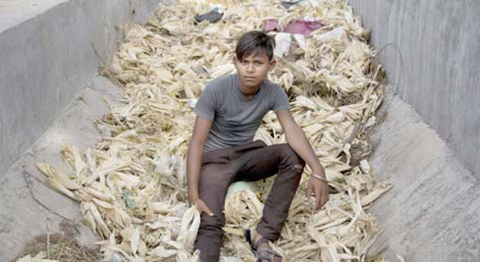Millions of children labor in India, some in sweltering heat
 NOIDA, India: In this June 8, 2017 photo, Indian boy Brijesh, who claims to be 16 year old but doesn’t know his birthday, poses for a photo as he sits on corn stalks next to a busy expressway. — AP
NOIDA, India: In this June 8, 2017 photo, Indian boy Brijesh, who claims to be 16 year old but doesn’t know his birthday, poses for a photo as he sits on corn stalks next to a busy expressway. — AP
NOIDA, India: Every 100 m or so along a busy expressway on the outskirts of New Delhi, you’ll find a child selling corn - quite possibly a child too young to be working legally. Twelve-yearold Prakash is one of them. Lolling amid the discarded husks from earlier sales, he doesn’t seem bothered by the 40 degree Celsius heat or the buzzing flies. “We all work together and live together,” he says, gesturing toward 15 or so other boys working the highway. Each is dropped off by their employer every morning with a sack full of boiled corn.
They spend their days trying to flag down drivers. They don’t leave until their sacks are empty, sometimes 12 hours later. Are all as young as Prakash? There’s no way to be sure. Each seems to change their age with each answer, often forgetting the number they previously mentioned. Most are careful, however, to use a number above 14 - the legal age in India to work in nonfamily enterprises.
Young men, whom the boys claim are their elder brothers, patrol the highway on motorcycles, ensuring business runs smoothly. They also tell them not to speak to visiting journalists. Most comply, anxious to keep jobs that pay about $80 per month - far more than they could earn back home.
All the boys have moved to Noida, southeast of New Delhi, from rural villages in search of work. Yesterday, the World Day Against Child Labor, the International Labour Organization said 168 million children are laborers, or about one in nine children overall. India, in its 2011 census, estimated the country had 8.3 million child laborers.
Uttar Pradesh state, where Noida is located, alone accounted for 1.8 million of that total. UNICEF says there has been an overall decline in child labor in India, but that urban areas have seen an increase. Meanwhile, Prakash and the other boys are still selling their corn late in the afternoon. Their sacks are not yet empty. Separately, the number of children trafficked for sex in the red light districts of Mumbai has dropped sharply, activists said, as they raised concerns over the trade shifting underground to private lodges and residences.
A study by the non-governmental International Justice Mission (IJM), Commercial Sexual Exploitation of Children in Mumbai, mapped nearly 10,000 commercial sex workers in more than 1,000 brothels, and about 200 sex workers operating from private establishments. In brothels, it found the prevalence of minors had dropped to 5.5 percent during the course of the study from 2015 to 2016, from an estimated 40 percent in the past.
It found 25 minors in private locations. “About six to seven years ago, a customer could talk to a pimp and ask for a young girl. Now, it is not possible. They will first say no, until they establish the customer is not a police informer,” said Sanjay Macwan, regional director for India at IJM. “We strongly believe the number of children has gone down.” He credited the drop to police anti-human trafficking units and new laws that have made sexual offences against minors punishable by a maximum of life imprisonment.
Macwan said the study was not aimed at tracking a shift of young girls from public to private venues, but it did point to the need for more research. “We need to understand how crime is going into covert spaces. Our biggest challenge was to find girls in private locations,” he told the Thomson Reuters Foundation. Some of Asia’s oldest and largest red light districts are in Mumbai, a key destination for trafficked women and children.
Most are lured from other states and neighboring countries, often with the promise of good jobs in a home or shop. Instead, many are forced into sex work or manual labor. The sex trade has shifted over the past five to 10 years from hot spots such as Kamathipura, Mumbai’s oldest red light district, to private lodges and residential areas. — Agencies




